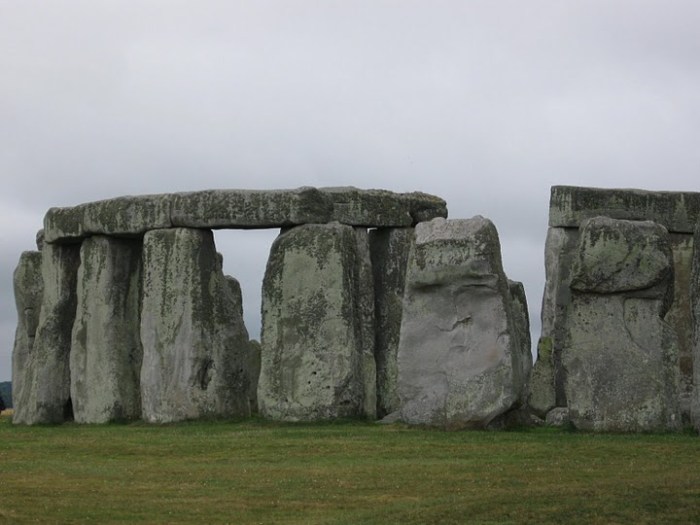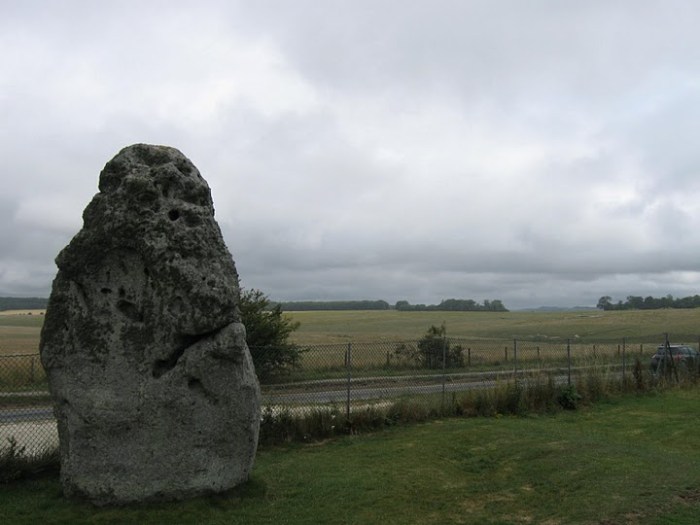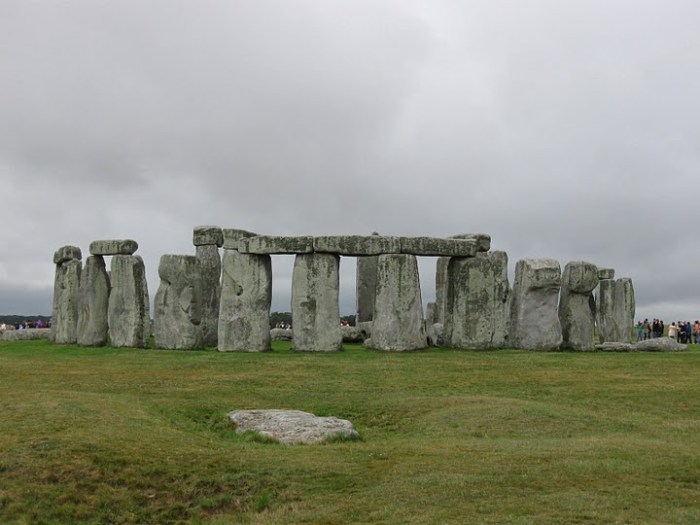Stonehenge. From the moment I read about it in a school history book, I wanted to visit it. Photographs of stone slabs in a circular formation should have been boring to a 10 year-old, but the opposite was true for me—I was fascinated with Stonehenge, so much so that everybody in my family knew about it. When I left for my year-long stay in London in September 2008, my father told me, “You’ll finally see the Stonehenge now.”
 And I finally saw Stonehenge for real at 11 am at on a wet, grey and rainy day in July 2009. Instead of elation and joy at having finally seen my “childhood dream”, my first reaction was one of intense disappointment — I had expected towering stone slabs rising up to the skies, but all I saw was a cluster of stony protrusions on a plain, featureless landscape. Added to this disappointment was the persistent rain that had followed me from London, leading to a perfect set-up for the much-anticipated visit to Stonehenge turning into a disaster.
And I finally saw Stonehenge for real at 11 am at on a wet, grey and rainy day in July 2009. Instead of elation and joy at having finally seen my “childhood dream”, my first reaction was one of intense disappointment — I had expected towering stone slabs rising up to the skies, but all I saw was a cluster of stony protrusions on a plain, featureless landscape. Added to this disappointment was the persistent rain that had followed me from London, leading to a perfect set-up for the much-anticipated visit to Stonehenge turning into a disaster.
I gave myself a strict talking to about not judging monuments by their appearance and to enjoy my visit as i walked towards the ticket office. I had almost cheered up when I saw the people lined up to buy tickets to see the monument. There were babies in prams, toddlers being given their first or maybe 11th history lesson by their fond parents; bored tweens and teens dragged around by determined parents. There were also busloads of bemused Italian, Spanish and Chinese students (who were in England to learn English) and trying their best to look interested as their instructors shouted out amidst the din: “Look at the stones and feel history and pre-history”.
I joined the pushing, shoving crowd with a sinking heart, but also with a determination to make the best of this tour. To my pleasant surprise, the tickets came with an audio guide, which, I found to my delight, completely shut out the din. And with a brochure on Stonehenge purchased from the souvenir shop, there was nothing to stop me from pretending that I was the only one there to see Stonehenge. “Seeing” the Stonehenge is actually a self-guided audio tour that takes the visitor around the Stonehenge, almost like a pradakshina or a circumambulation. Visitors cannot get up close and personal with the Stonehenge all—a safe distance of at least 50 m is maintained between the two.

Stonehenge, a UNESCO World Heritage Site, is in the Wiltshire county of England and lies at the centre of a landscape rich in prehistoric remains—there are other pre-historic sites within a 20 km radius of the Stonehenge. The word ‘henge’ means a circular bank of earth surrounding an inner ditch. Stonehenge actually began as a timber structure (the marks of which are still there in the ground), and was later replaced by stone slabs we see today. The inner circle of smaller stones are known as bluestones, because of the blue colour they exhibit when wet or freshly chipped, while large, outer stone slabs are called Sarsens.
The Sarsens, some of which weigh up to 50 tons, are an iron rich sandstone and their provenance has been traced to Marlborough Downs, about 30 km away. The bluestones, a type of dolerite and the largest of which weigh 5 tons, is from the Preseli Hills of Wales, some 240 km away. Herein lies the problem that has puzzled scholars all these years: how did the stones get here at a time of no transport, and no visible engineering skills? Some of the theories bandied about for the presence of the stones, particularly the bluestones, in an otherwise barren chalky landscape are as follows: glacial drift; aliens (yes, they existed in pre-history as well); the devil dropped them at this particular spot; Merlin the druid/magician magicked them here; by sea and river using rafts; etc.



Personally, I feel that the reason we have not been able to understand or appreciate how the pre-historic people transported the stones is because we are trying to contextualise it with technology that we use or are aware of. While experts are not too sure about how the stones came to be here, they are reasonably sure that Stonehenge was a place of worship and sacrifice. The discovery of barrows or burial mounds nearby have also confirmed it as a burial site.
Stonehenge is at the heart of an elaborately sculpted landscape and the people who built it had good knowledge of astronomy as the stones are perfectly aligned with the summer and winter solstices. Experts believe that in pre-historic times there would have been processions to mark these important days, when ceremonies and perhaps, sacrifices would be held in Stonehenge.

Look at the above picture carefully, particularly the background. Do you see a gap in the trees? Processions would pass through that gap, down the hill to the large stone projection in the left of the picture, known as the Heel Stone, and straight into the Stonehenge. That path, which is faintly visible from the air, is called the Avenue.

The audio guide had lot of interesting trivia to offer. For instance, the uneven colouring on the Sarsens is not because of weathering, but due to the presence of lichens. There are reportedly 93 varieties of lichens present on this site and many of them are not present anywhere else in the UK. Another piece of trivia was about the Slaughter Stone (see photograph above). For long, this fallen piece of stone with reddish stains was considered to be the site for sacrifice. It was only when chemical tests were conducted on the stone that it was revealed that the red colour was due to oxidation of the iron-rich Sarsens. Also the stone had not always been in a recumbent position—in the past it had been standing in an upright position.
 The Stonehenge pradakshina can be completed in about 30 minutes, but I took nearly an hour-and-a-half to complete mine. The audio guide was excellent and with the brochure I had purchased, I could actually make many more stops not just to notice the features but also to imagine what it must have been like so many millennia away. My earlier disappointment and irritation vanished in no time only to be replaced by a fervent wish to discover the secrets that the stones have stored over the millennia. Even the “uninteresting” Wiltshire countryside suddenly seemed reveled in all its green and golden glory.
The Stonehenge pradakshina can be completed in about 30 minutes, but I took nearly an hour-and-a-half to complete mine. The audio guide was excellent and with the brochure I had purchased, I could actually make many more stops not just to notice the features but also to imagine what it must have been like so many millennia away. My earlier disappointment and irritation vanished in no time only to be replaced by a fervent wish to discover the secrets that the stones have stored over the millennia. Even the “uninteresting” Wiltshire countryside suddenly seemed reveled in all its green and golden glory.

I couldn’t help wondering as to why has a circular arrangement of stones captivated the imagination of historians, archaeologists, anthropologists, writers, artists, photographers, tourists like me… Is it because of its location? Is it because of the mystery surrounding its origins? Is it because one cannot get up close and personal with the stone slabs? Is it because of the possible druidical and pagan rituals associated with it?
If only the stones of Stonehenge could speak—speak of the centuries and millennia gone by, speak of all that they have heard and witnessed.
If only the stones could speak…

Nice one!! audio guides are really a boon to those of us who really want to know about the place! it allows us to take our own sweet time without being hurried by a guide… i first experienced this at udaipur where, to my surprise, even my son who normally hurries through, stopped at every single portrait, listened, sometimes re-listened and took his own time! loved the description too,, have also wanted to go there, but the time hasnt yet come!
LikeLike
I hope the time comes soon, Anu. Just a tip—do visit on a weekday and avoid the equinoxes. On weekdays, the crowds are definitely less, and even though the audio guides shut out the din, its nice to not bump into someone else or wait your turn to look at a particular feature.
LikeLike
wow- fabulous shots. loved this too much. wish to c it too.
LikeLike
Thanks, Sush. I hope your wish comes true. Soon. 🙂
LikeLike
Well written article. I have never visited this place and always been fascinated by it. Most of the photos I have seen are those in which the place is deserted. Now, I see the real place through your lens. 🙂
LikeLike
They say that a photograph is worth a thousand words. It can also hide a thousand secrets. 😉 Stonehenge was crowded, yes, but it was nothing compared to the crowds one sees at Indian monuments.
LikeLike
Yes, Sudhagee. If only they could speak.
A great article which beautifully brings to light all the puzzles and mysteries associated with Stonehenge. 🙂
LikeLike
Thank you so much, Chhavi. 🙂
LikeLike
It is one of the places where I would love to visit. I like mysterious places and this is one of them 🙂
By the way, here is my IndiVine post. Check it and if you like it then please Promote it too there on IndiVine.
http://www.indiblogger.in/indipost.php?post=72607
Thanks 🙂
LikeLike
The Stonehenge is a mystical, magical, mysterious place. And if you love such places, then Stonehenge is the place for you. 🙂
LikeLike
Monuments in stone
living in a world
of their own..
The mystery of
their silence
gently unfolds
the realization
that so much
is yet unknown..
Thank you for bringing life to this marvel of history…great post..
LikeLike
Ahh Deepa, I wish I could write verse like you. Your comments always enrich my posts. Thank you so much 🙂
LikeLike
Lovely post!
I remember reading about Stonehenge recently in some blog and it has been on my mind ever since. I wish I could go visit some day.
LikeLike
Edit. I wish I can go visit some day. 😀
LikeLike
And I hope that your wishes get translated into reality. Sooner rather than later 🙂
LikeLike